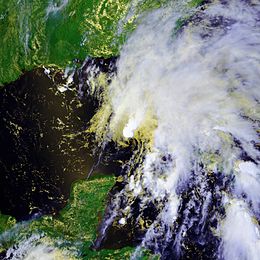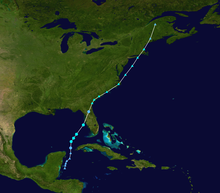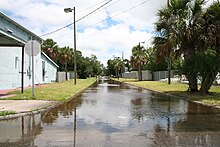Tropical Storm Barry (2007)
| Tropical storm (SSHWS/NWS) | |
 Tropical Storm Barry | |
| Formed | June 1, 2007 |
|---|---|
| Dissipated | June 2, 2007 |
| Highest winds | 1-minute sustained: 60 mph (95 km/h) |
| Lowest pressure | 997 mbar (hPa); 29.44 inHg |
| Fatalities | 1 direct, 2 indirect |
| Damage | Minimal |
| Areas affected | El Salvador, western Cuba, Florida, East Coast of the United States |
| Part of the 2007 Atlantic hurricane season | |
Tropical Storm Barry was a tropical cyclone that grew quickly. It made landfall in Florida in early June 2007. It was the second Atlantic named storm of the 2007 Atlantic hurricane season. Barry formed in the Gulf of Mexico and moved toward the northeast, reaching top wind speeds of 60 mph (95 km/h). It then weakened and first reached land near Tampa Bay, Florida. Barry quickly weakened after wind shear blew away most of the thunderstorms. Barry moved up the East Coast of the United States, and by June 5, it was taken over by an even bigger storm.
Rain from Barry in the Cuban province of Pinar del Río hurt three people and damaged 55 houses.[1] In Florida, Barry caused heavy rain in an area that had been in a drought. Flooding and wet roads killed two people in traffic accidents. Rough seas killed one surfer in Pinellas County, Florida. In Florida and Georgia, the rain helped firefighters fight wildfires. Damage from the storm was minor.
Storm history[change | change source]

On May 29, a weather system in the Yucatán Peninsula created a small area of thunderstorms over the Yucatán Channel.[2] The thunderstorms got stronger near the weather system. By May 30, clouds from the area reached from Nicaragua to the southeastern Gulf of Mexico.[3] Another weather system, called a tropical wave, created a storm on May 30. The next day, a cyclone formed inside the system. The storm moved towards the north-northeast,[4] and slowly gained strength.[5] More thunderstorms formed near the center, and the system became a tropical depression.[4] A tropical depression is a type of storm.
The depression developed an area of squalls (sudden, violent storms with wind and rain). A Hurricane Hunters airplane flew into the area to collect information about the cyclone.[6] At the beginning, the tropical depression looked to be both a tropical and subtropical cyclone. On June 1, the National Hurricane Center named the storm Tropical Storm Barry. Barry was now 235 miles (375 km) to the west of Key West, Florida.[7] Barry moved quickly towards the north.[7] On June 2, it reached its strongest with winds of 60 mph (95 km/h).[4]
After Barry reached its maximum strength, strong wind shear removed most of the thunderstorms from the tropical cyclone.[8] The center of the system then increased in length, and it began to weaken. At 1400 UTC on June 2, Barry made landfall near Tampa, Florida while it was at tropical depression status.[9] As Barry moved inland, it weakened more. Later that day, the National Hurricane Center said that Barry had died out over northeastern Florida.[10] What was left of Barry continued to move northeast. On June 3, it moved onto shore again, this time in South Carolina.[11] Late on June 4, the extratropical system entered New England.[12] Late on June 5, what was left of the cyclone was taken over by a larger weather system, near the border of the U.S. state of Maine and the Canadian province of Quebec.[4]
Preparations[change | change source]

When Barry was named as a tropical storm, the National Hurricane Center sent out a tropical storm warning for the west coast of Florida from Bonita Beach through Keaton Beach. Also, a tropical storm watch was issued from Keaton Beach, northward to Saint Marks.[13] An inland tropical storm warning was also sent out for inland parts of Charlotte, Citrus, DeSoto, Hardee, Hernando, Highlands, Lee, Levy, Manatee, Pasco, Pinellas, Polk, Sarasota, and Sumter counties. The storm increased the risk of rip currents, so officials told swimmers to stay out of the water until the storm left the area.[14] A tornado watch was sent out for the southern part of the state, but it was removed after the storm lost strength.[15]
After Barry became an extratropical cyclone, National Weather Service offices sent out flood watches for parts of:[11] South Carolina, eastern North Carolina, southeastern Virginia, and southeastern Maryland. Flood watches were also sent out for:[16] southeast Pennsylvania, northern Delaware, northern New Jersey, east-central New York, southern New England. A wind advisory was sent out for parts of Georgia.[17]
Impact[change | change source]
Florida[change | change source]
Barry caused heavy rain in Florida. The heaviest rain was 6.99 inches (178 mm) at Palm Beach International Airport. Other areas reported over 3 inches (75 mm) of rain.[11] The rain helped to get rid of drought conditions.[15] It also helped in fighting bad wildfires across the state.[18] In Brevard County, the rain caused a large sinkhole, a hole in the ground, to open in the middle of a road. Other roads were flooded.[19] On Interstate 95, near Lake Worth, another sinkhole closed two lanes of traffic.[20] Wet slippery roads caused many traffic accidents in the state. In Brevard and Volusia counties, drivers were killed in traffic accidents. On Interstate 4, a tractor trailer crashed into a guardrail because of the weather.[21]
The storm caused stormy seas along the coastline of Florida, with a storm surge of 4.78 feet (1.46 m) at Clearwater Beach. The waves caused minor beach erosion. The high surge also caused minor flooding on many roads near Tampa Bay.[22][23] At Indian Shores, a woman died after being injured by the high seas.[22][24]
Barry caused high winds in Florida, which reached 47 mph (76 km/h), near the southeastern coastline of the state.[25] The winds knocked down trees and caused power failures.[26] In Carrolwood, one person was injured when a tree crashed onto their house.[22] The storm created at least two tornadoes, including some that damaged fences and power lines. One possible tornado in Goulds, Florida left about 2,000 people without power.[15]
Rest of the country[change | change source]
| Location | inch | mm |
|---|---|---|
| West Palm Beach, Florida | 6.99 | 178 |
| Mount Vernon, Georgia | 8.00 | 203 |
| Near Hardeeville, South Carolina | 6.12 | 156 |
| Fuquay-Varina, North Carolina | 3.73 | 94.7 |
| Pennington Gap, Virginia | 3.75 | 95.3 |
| Frostburg, Maryland | 1.70 | 43.2 |
| Dover, Delaware | 1.54 | 39.1 |
| Philadelphia, Pennsylvania | 1.66 | 42.2 |
| Absecon, New Jersey | 4.50 | 114 |
| Central Park, New York | 3.91 | 99.3 |
| Berlin, Connecticut | 2.90 | 73.7 |
| Taunton, Massachusetts | 3.19 | 81.0 |
| Burrillville, Rhode Island | 3.10 | 78.7 |
| Newmarket, New Hampshire | 2.75 | 69.9 |
| Saco, Maine | 2.64 | 67.1 |
The storm also caused heavy rain in Georgia of up to 8 inches (203 mm).[16] The rain helped put out wildfires.[28] It also caused some minor flooding, and in Savannah, there were a few minor car accidents.[29] Winds blew down some trees and power lines.[30] Heavy rain from the storm moved across much of the East Coast of the United States.[16] High winds also occurred in South Carolina.[31]
The remains of Barry caused strong winds along the Atlantic coast. They reached 60 mph (97 km/h) near Charleston, South Carolina.[11] Around 200 houses in Craven County, North Carolina lost power.[32] In southeastern Virginia, the storm caused over 60 traffic accidents. Ten people were injured in them.[33] High seas off Cape Fear left a sailboat with three people needing rescue from the Coast Guard.[34]
Rain went north into the Mid-Atlantic States and New England, with 4.50 inches (113 mm) at Absecon, New Jersey, 3.91 inches (99 mm) near Central Park, New York, and 3.19 inches (81 mm) at Taunton, Massachusetts.[27] Flooding damaged several roads and driveways in the Finger Lakes region of New York State.[35] Flash floods were seen in southeast New York, and high wind gusts caused some damage to trees.[36] In New Jersey, winds pushing over land caused high tides and minor coastal flooding.[37]

Tornadoes[change | change source]
| List of confirmed tornadoes – June 1, 2007 | ||||||
|---|---|---|---|---|---|---|
| "Rating" | Location | County | Location | Time (UTC) | Path length | Damage |
| Florida | ||||||
| EF0 | East-northeast of Sugarloaf Key | Monroe | 24°40′N 81°31′W / 24.66°N 81.52°W | 1655 | 0.6 miles (1.0 km) | Brief touchdown, a 30-foot ficus tree was downed and caused minor damage to two homes. Caused $20,000 in damages. |
| EF1 | Cutler Bay area | Miami-Dade | 25°34′N 80°21′W / 25.57°N 80.35°W | 0145 | 3.9 miles (6.3 km) | A few large trees were uprooted and several large limbs broken off, along with roof and fence damage to homes. Caused $20,000 in damages. |
| Sources: NCDC Tornado database files | ||||||
Related pages[change | change source]
- 2007 Atlantic hurricane season
- List of tropical cyclone names
- List of hurricanes in Florida
- List of hurricanes in Connecticut
References[change | change source]
- ↑ EFE (2007). "La tormenta tropical "Barry" baña con sus lluvias a Cuba" (in Spanish). Cuba Debate. Retrieved 2007-06-02.
- ↑ Waddington (2007). "May 29 Tropical Weather Discussion". National Hurricane Center. Retrieved 2013-04-04.
- ↑ John Cangialosi (2007). "May 30 Tropical Weather Discussion". National Hurricane Center. Retrieved 2013-04-04.
- ↑ 4.0 4.1 4.2 4.3 Lixion Avila (2007). "Tropical Storm Barry Tropical Cyclone Report" (PDF). National Hurricane Center. Retrieved 2007-06-22.
- ↑ John Cangialosi (2007). "May 31 Tropical Weather Discussion (2)". National Hurricane Center. Retrieved 2013-04-04.
- ↑ Avila (2007). "June 1 Tropical Weather Outlook". National Hurricane Center. Retrieved 2013-04-04.
- ↑ 7.0 7.1 Avila (2007). "Tropical Storm Barry Discussion One". National Hurricane Center. Retrieved 2007-06-01.
- ↑ Avila (2007). "Tropical Storm Barry Discussion Two". National Hurricane Center. Retrieved 2007-06-01.
- ↑ Avila & Proenza (2007). "Tropical Storm Barry Discussion Four". National Hurricane Center. Retrieved 2007-06-01.
- ↑ Avila (2007). "Tropical Storm Barry Discussion Five". National Hurricane Center. Retrieved 2007-06-01.
- ↑ 11.0 11.1 11.2 11.3 Rubin-Oster (2007). "Public Advisory Number 7 for Remnants of Barry". Hydrometeorological Prediction Center. Retrieved 2013-04-04.[permanent dead link]
- ↑ Fracasso (2007). "Public Advisory Number 13 for Remnants of Barry". Hydrometeorological Prediction Center. Retrieved 2013-04-04.[permanent dead link]
- ↑ Avila (2007). "Tropical Storm Barry Public Advisory One-A". National Hurricane Center. Retrieved 2007-09-25.
- ↑ Ruskin, FL National Weather Service (2007). "Tropical Storm Local Statement". Retrieved 2007-06-01.
- ↑ 15.0 15.1 15.2 Martin Merzer (2007). "Barry weakens but drenches South Florida". The Miami Herald. Retrieved 2007-06-02.[dead link]
- ↑ 16.0 16.1 16.2 Kong (2007). "Public Advisory Number 9 for Remnants of Barry". Hydrometeorological Prediction Center. Retrieved 2013-04-04.[permanent dead link]
- ↑ "Tropical Storm Barry Event Report for Georgia". National Climatic Data Center. Retrieved 2008-11-19.
- ↑ First Coast News (2007). "Tropical Storm Barry Helps Out Wildfires". Retrieved 2007-06-03.[dead link]
- ↑ Susanne Cervenka (2007). "Barry brings precious gift of rain". Florida Today. Archived from the original on 2007-06-06. Retrieved 2007-06-03.
- ↑ Kimberly Miller (2007). "Welcome rains carve sinkholes in I-95". The Palm Beach Post. Archived from the original on 2012-05-29. Retrieved 2007-06-03.
- ↑ WFTV-9 (2007). "Barry Downgraded After Soaking Central Florida". Archived from the original on 2012-08-13. Retrieved 2007-06-03.
{{cite web}}: CS1 maint: numeric names: authors list (link) - ↑ 22.0 22.1 22.2 McMichael (2007). "Tropical Storm Barry Post Tropical Cyclone Report". Ruskin, Florida National Weather Service. Archived from the original on 2018-09-15. Retrieved 2007-06-11.
- ↑ Fox13 (2007). "Barry leaves his calling card". Archived from the original on 2020-07-27. Retrieved 2007-06-03.
{{cite web}}: CS1 maint: numeric names: authors list (link) - ↑ "Tropical Storm Barry Event Report for Florida". National Climatic Data Center. Retrieved 2013-04-04.
- ↑ "Tropical Storm Barry brings rain to Florida". Associated Press. 2007. Archived from the original on 2007-09-30. Retrieved 2007-06-02.
- ↑ Tiffany Pakkala (2007). "Barry dumps 5 inches of rain on area". The St. Augustine Record. Archived from the original on 2013-11-03. Retrieved 2007-06-03.
- ↑ 27.0 27.1 Fracasso (2007). "Public Advisory Number 14 for Remnants of Barry". Hydrometeorological Prediction Center. Archived from the original on 2013-04-05. Retrieved 2007-06-03.
- ↑ "First significant rain in weeks gives fire crews much-needed break". Associated Press. 2007. Archived from the original on 2007-09-26. Retrieved 2007-06-03.
- ↑ Savannah Morning News (2007). "Barry brings relief with 5 inches of rain". Retrieved 2007-06-03.[dead link]
- ↑ "Tropical Storm Barry Event Report for Georgia (2)". National Climatic Data Center. Retrieved 2008-11-25.
- ↑ "Tropical Storm Barry Event Report for South Carolina". National Climatic Data Center. Retrieved 2008-11-25.
- ↑ Charlie Hall (2007). "Barry causes few problems in region". New Bern Sun Journal. Archived from the original on 2007-09-29. Retrieved 2007-06-04.
- ↑ Steve Stone and Amy Coutee (2007). "Tropical storm's leftovers force cancellations across region". The Virginian-Pilot. Archived from the original on 2012-10-02. Retrieved 2007-06-04.
- ↑ "Boaters off Cape Fear rescued". Daily Press. 2007. Archived from the original on 2013-06-30. Retrieved 2007-06-03.
- ↑ "Tropical Storm Barry Event Report for New York". National Climatic Data Center. Retrieved 2008-11-19.
- ↑ "Tropical Storm Barry Event Report for New York (2)". National Climatic Data Center. Retrieved 2008-11-19.
- ↑ "Tropical Storm Barry Event Report for New Jersey". National Climatic Data Center. Retrieved 2008-11-25.
Other websites[change | change source]
- HPC rainfall page for Barry Archived 2008-06-16 at the Wayback Machine
- NHC Tropical Cyclone Report for Barry
- Weather Discussions Storm Archive[permanent dead link]
|
Tropical cyclones of the 2007 Atlantic hurricane season | |||||||||||||||||||||||||||||||||
|
|
| ||||||||||||||||||||||||||||||||
|
| |||||||||||||||||||||||||||||||||
- 2007 Atlantic hurricane season
- Atlantic tropical storms
- Hurricanes in the United States
- 2007 in New Jersey
- 21st century in El Salvador
- 2000s in Cuba
- 2007 in Florida
- 2007 in Georgia (U.S. state)
- 2000s in South Carolina
- 2000s in North Carolina
- 2000s in Virginia
- 2000s in Maryland
- 21st century in Delaware
- 2000s in Pennsylvania
- 2000s in New York (state)
- 2000s in Connecticut
- 2007 in Massachusetts
- 2000s in Rhode Island
- 2000s in New Hampshire
- June 2007 events
